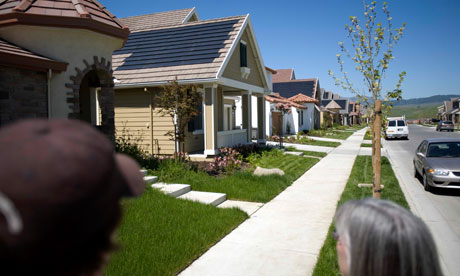Those looking for a reasonably priced home might head north. It's cold up there, but the deals are hot. Binghamton, N.Y., Syracuse, N.Y., Buffalo, N.Y., and Rochester, N.Y., lead our list of affordable housing markets; 89.4%, 87.8%, 84.1% and 80.6% of homes sold in the last quarter, respectively, were available to each city's median-earning family.
The national average is 62.4%. In New York City, the least affordable market, only 14% of homes are available to median earners.
Better yet about those upstate locales? All four beat the national average of -12.4% when it comes to price appreciation, with price fluxes of between -10% and 2% over the past year.
Of course, in this economic environment, in which housing starts are at a record low since the U.S. Commerce Department started tracking them after World War II, and President Obama says 9 million Americans are facing foreclosure, high growth means a scant 0.8% year-over-year improvement, as was the case in Buffalo, according to the National Association of Realtors (NAR).
Behind the Numbers
Our list comes from the National Association of Home Builders (NAHB)/Wells Fargo Housing Opportunity Index, which examines the country's 222 largest metropolitan areas and measures the percentage of homes sold in the last quarter that were affordable to the median earning family, based on current interest rates. Because, in this market, "affordable" might seem like a euphemism for "bottomless pit," we excluded any city where home prices fell by more than 10% last year, according to the NAR.
That eliminated many "affordable" cities like Detroit or Phoenix, where prices have plunged by more than 20% and offer little to the buyer looking to build equity in a relatively stable area. What was left were cities that avoided the housing boom and haven't suffered from major economic meltdowns. These include Greensboro, N.C., or Chattanooga, Tenn.
Getting Housing Back on Track
Though many are focused on sheer price measures, it's affordability--prices that are in line with income levels--that's key to enticing new buyers and strengthening the housing market. Based on historical trends, housing hasn't been this affordable since 2003, according to the NAHB, thanks in large part to the deterioration of housing prices to that year's levels.
Also expected to help: 50-year-low mortgage rates and the $8,000 tax credit for qualified first-time home buyers. Even so, with national prices down 12.5% last year (according to the NAR), a difficult credit market and the disintegration of mortgage securitization, the supply of buyers and banks to lend them money has been constrained.
"Falling home prices and very favorable mortgage rates both contributed to the housing affordability gains we saw in the fourth quarter of 2008," says Joe Robson, NAHB chairman. "However, at the same time, worsening economic conditions, historically low consumer confidence and uncertainty about future home prices kept many qualified buyers on the sidelines."
One key to affordability is price stability. Consider Columbus, Ohio, and Pittsburgh, Pa., whose median home prices are $126,500 and $109,100, respectively. During the housing boom between 2002 and 2006, neither city saw breakneck increases in value.
Unlike speculator havens such as Phoenix or Los Angeles, where prices increased by between 10% and 20% per year, these two cities saw modest gains of between 2% and 5%. Because prices rose evenly, with the rate of income increases and inflation, thanks to a lack of speculation, neither city went through big price swings. All this kept home prices in line with the local economies.
Even so, prices in Columbus and Pittsburgh are down are down 7.8% and 6.7%, respectively, as the local economies have faltered.
Another cause for price declines in the country? A lack of mortgage securitization, akin to insurance, which brings investors into the mortgage market and, as a result, makes credit available to home buyers. Private securitization has shrunk from 60% of the market three years ago to less than 25% today, hurting the flow of credit.
"It is unlikely that any securitization will proceed without extensive government support in the current environment," says Anthony Sanders, professor of finance at Arizona State University. "In addition, home prices continue to fall, and there is a great deal of economic uncertainty. Investors are unlikely to enter this market until these two problems are resolved."
The good news? At least no one is issuing high-risk loans anymore. As of January, the writing of new subprime, prime jumbo and Alt-A loans fell 98% in year-over-year terms, down to $11.1 billion, according to Inside MBS & ABS, a mortgage industry newsletter.
And we can all look forward to the day when we don't have to think about subprime anymore. In the meantime, it's best to be in a less volatile market where you don't need a creative loan to afford the price of the home.
Out of the 222 largest metros in the U.S., these are 10 cities where high percentages of the population can afford the homes being sold and where prices haven't dropped by more than 10% over the last year.




































